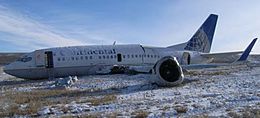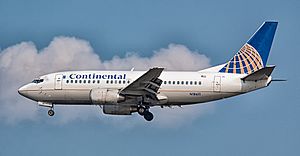Continental Airlines Flight 1404 facts for kids

Flight 1404 after crash
|
|
| Accident summary | |
|---|---|
| Date | December 20, 2008 |
| Summary | Runway excursion due to pilot error in abnormal wind gust that the industry did not train for |
| Place | Denver International Airport, Denver, Colorado 39°52′30″N 104°41′13.24″W / 39.87500°N 104.6870111°W |
| Passengers | 110 |
| Crew | 5 |
| Injuries (non-fatal) | 38 |
| Fatalities | 0 |
| Survivors | 115 (all) |
| Aircraft type | Boeing 737-524 |
| Airline/user | Continental Airlines |
| Registration | N18611 |
| Flew from | Denver International Airport, Denver, Colorado |
| Flying to | George Bush Intercontinental Airport, Houston, Texas |
Continental Airlines Flight 1404 was a flight operated by Continental Airlines. It was scheduled to fly from Denver International Airport in Colorado to George Bush Intercontinental Airport in Houston, Texas. On the evening of December 20, 2008, the plane had an accident during takeoff from Denver.
The Boeing 737-524 aircraft was badly damaged. Thirty-eight people were injured, but thankfully, everyone on board survived the crash.
| Top - 0-9 A B C D E F G H I J K L M N O P Q R S T U V W X Y Z |
What Happened?
On December 20, 2008, around 6:18 PM local time, Flight 1404 was cleared for takeoff. As the plane sped down runway 34R at Denver International Airport, it suddenly veered off course. The aircraft left the side of the runway and skidded across a taxiway and a service road.
It then crashed into a 40-foot-deep ravine not far from the runway. The right engine caught fire, and the flames quickly spread to the main body of the plane.
Even though there was some confusion at first, firefighters arrived quickly. The plane had stopped near one of the airport's fire stations. When help arrived, a large part of the right side of the plane was burning. Passengers were climbing out of the left side.
Flight attendants and an off-duty Continental Airlines pilot helped everyone get out safely. The off-duty pilot, Richard Lowe, even went back into the burning plane several times to make sure no one was left behind. He later received an award for his brave actions.
The plane was severely damaged in the crash. The main body of the plane cracked right behind the wings. One engine and the main landing gear broke off. The nose gear, which is at the front of the plane, also collapsed. The fire was so hot that the overhead luggage compartments melted onto the seats. This accident was the most serious event in Denver International Airport's history. The aircraft was so damaged it could not be used again.
Injuries from the Crash
There were 110 passengers and five crew members on Flight 1404. All 115 people survived the crash. Thirty-eight people were injured, some with broken bones. Two passengers and one crew member were seriously hurt at first. However, their conditions improved quickly. By the next morning, only a few people were still in the hospital.
The 50-year-old Captain, David Butler, was among those seriously injured. He had severe back injuries and bone fractures. The first officer, 34-year-old Chad Levang, had only minor injuries.
How the Investigation Unfolded
Investigators found the plane's black boxes (which record flight data and sounds) in good condition. The cockpit voice recorder showed no problems until 41 seconds after the plane started moving for takeoff. At that point, a bumping sound was heard. The crew stopped the takeoff four seconds later. Both recorders stopped working six seconds after that, before the plane came to a complete stop. During this time, the plane reached a speed of about 137 miles per hour (220 km/h).
When interviewed, First Officer Levang told investigators he didn't notice any problem until the plane was going about 100 to 103 miles per hour (161 to 166 km/h). Then, the plane suddenly moved away from the runway's center line and made a "sudden left turn." He said Captain Butler was flying the plane at the time. Captain Butler was too injured to be interviewed right away. Both pilots had excellent safety records and were very experienced.
Marks on the ground and reports from passengers and firefighters suggested the plane was briefly airborne. It was not clear when the fire started. There was no snow or ice on the runway. However, there were strong crosswinds of about 36 miles per hour (58 km/h) at the time.
The flight crew who flew the plane to Denver before the accident flight was also on board, but not working. They reported no problems with the plane during their earlier flight. The plane had an engine failure and made an emergency landing in 1995. Both engines were replaced after that incident, but the plane was not otherwise damaged.
At first, people thought a problem with the landing gear might have caused the crash. They thought a wheel might have locked up during takeoff. However, the National Transportation Safety Board (NTSB) found that the engines seemed to be working fine. The plane's tires were inflated, and the brakes did not seem to have failed. This meant the landing gear was not the cause.
Later, the focus shifted to strong winds or possibly ice. Captain David Butler said he thought they either hit a very strong gust of wind or some ice. He also mentioned that he stopped pushing on the rudder controls because they seemed to stop working. Winds were reported between 28 and 31 miles per hour (45 and 50 km/h) from the northwest. Gusts reached almost 37 miles per hour (60 km/h) just before the plane started its takeoff. A Boeing 737 can handle crosswinds up to 38 miles per hour (61 km/h) on a dry runway.
The NTSB investigation found that a wind sensor at one end of the runway showed a crosswind of 46 miles per hour (74 km/h). Analysis showed the plane was hit by a peak gust of 52 miles per hour (84 km/h). This was much higher than the wind data given to the pilots before takeoff. It was also much higher than what pilots were trained for in the airline industry.
The NTSB also looked at over 250,000 takeoffs involving Boeing 737-500s. They found that less than 0.002% of those flights experienced crosswinds above 35 miles per hour (56 km/h). This meant it was almost impossible for a pilot to have real-life experience with such strong crosswinds. The NTSB believed this is why the pilot thought his rudder controls weren't working. He then focused on other ways to control the plane, which were not enough for the situation.
On July 13, 2010, the NTSB announced the main cause of the accident. It was the captain stopping his input on the right rudder. This was needed to keep the plane going straight. He stopped about four seconds before the plane went off the runway, when it hit a very strong and gusty crosswind. A contributing factor was that pilot training for extreme wind gusts was not good enough in the airline industry. Another factor was that air traffic control (ATC) was not required to give pilots enough detailed wind information.
Because of the NTSB report, the Federal Aviation Administration made changes. They required airlines to improve pilot training for crosswinds. They also required ATCs to give pilots more detailed wind information, not just averages.
TV Show About the Crash
The crash of Continental Airlines Flight 1404 was featured in an episode of the TV show Mayday. The episode was called "Runway Runoff" and was part of season 19 in 2019.
Images for kids
See also
 In Spanish: Vuelo 1404 de Continental Airlines para niños
In Spanish: Vuelo 1404 de Continental Airlines para niños




